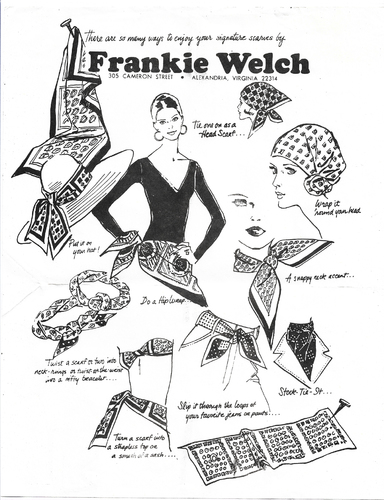Expanding the Business
By the mid-1960s, the presence of a designer's name on a scarf was expected and desired, to the point that the signature scarf had become its own category of fashion accessory. One reason for the popularity of signature scarves was that they provided an affordable and obvious way to acquire and show off ownership of a designer item.
In 1969, Welch decided to expand her scarf design business. She sent brochures about her work to 5,000 large companies and institutions inviting them to commission her to design custom scarves with the company’s logo or motto and the executives’ signatures. She embraced how scarves could express the specific interests of the wearer. She explained, “Ten years ago…people tried to cover up their affiliations. They wore their labels on the inside. Now they’re wearing them on the outside.”
Welch explained her design process as follows: “I often met someone and in a conversation would ask about them, their logo, and as we talked I would begin sketching. I would grab a cocktail napkin from the airplane, a notecard from the person, a scrap of paper and we went over the design right then.” She said, “You have to study the organization and find out what makes it tick to come up with a design that really signifies them.”
Welch believed that no matter what the subject of a scarf was, the design must be fashionable. She adjusted the formats and designs of her scarves over time to keep with current styles. Her earliest scarves primarily were large squares or long rectangles, usually of silk or cotton, and incorporated a lot of text. In a promotional brochure in 1969, she noted that including typography, calligraphy, or handwriting would make a scarf fashionable.

